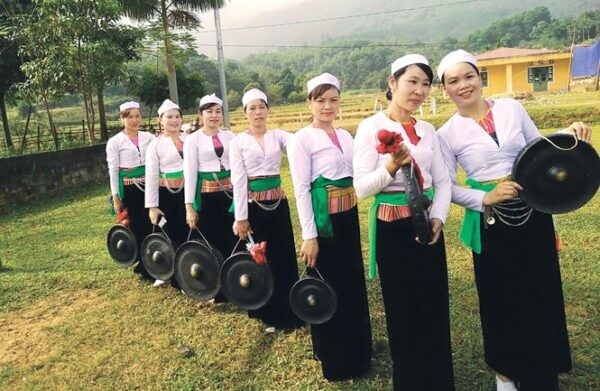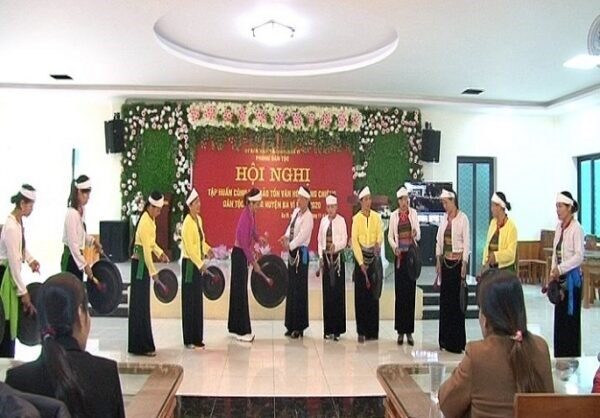In Ba Vi district, the Muong ethnic people live in a large proportion in 7 communes: Ba Trai, Minh Quang, Khanh Thuong, Ba Vi, Tan Linh, Van Hoa, Yen Bai. The Muong ethnic group has its own unique culture from customs, language, to community activities, including the art of gongs. Ba Vi district has been actively preserving and promoting the value of gong culture in the life of the Muong people, contributing to enriching the cultural identity of the ethnic groups in Vietnam.ư

Gong is a special “spiritual dish” of the Muong ethnic group.
Photo by Dien Khanh
Due to the difficult terrain, the Muong have used sound as a means of communication since ancient times. Therefore, every time the gong sounds resound, the Muong rely on the nuances of the sound to know the work of the village to gather. For example, the sound of gongs to welcome New Year’s Eve “pin, pong, pinh” is bustling, the rhythm from low to high echoes into the cliff not only creating a bustling and joyful atmosphere but also carrying a sacred meaning to invite Muong ancestors to celebrate Tet. The jubilant gong sounded as if urging everyone to join. The sound of gongs is also the confession of boys and girls on moonlit nights… The art of performing gongs of the Muong people in Ba Vi district focuses on the way of attachment, has a unique timbre with expressiveness and precision, helping listeners feel the content of each gong beat. The structure of the gongs of the Muong people has a knob in the middle and is beaten with an awl. The way to play is also different, the gongs of the Muong have a handle. When playing, each person carries a gong, the player is a woman, wearing traditional costumes including a pan, a black skirt, a white scarf on the head, a silver necklace, and multi-patterned belt, etc.
However, for a long time, gongs in Ba Vi district were rarely performed, even absent from people’s lives. In the past, almost every Muong family had a gong, at most a set of 12 pieces, representing the 12 months of the year. Later, due to war, life was difficult, some people had to sell gongs or not use them for a long time, causing the gongs to become distorted or broken. In order to preserve this unique culture, since 2012, Ba Vi district has implemented the project “Restoring, preserving and developing ethnic cultural identity” and have evaluated and researched cultural identity in 7 mountainous communes. Each commune was invested with 3 sets of gongs, the cultural and artistic key members of the communes were sent to train and exchange, gong teams and clubs were established and the people were also more aware of the preservation and promotion of their cultural values. The preservation and promotion of national cultural values in Ba Vi district is always associated with building a new cultural life, eliminating backward customs and superstitions. In 2020, Ba Vi District Ethnic Minority Office advised the District People’s Committee to buy 3 sets of standard gongs to give to clubs in Ba Trai, Khanh Thuong, and Tan Linh communes, bringing the total number of villages with gong sets to 24 of 76 villages with concentrated Muong people. In addition to supporting standard sets of gongs, the district authority also opens classes to teach gong music to the communes.

Training gongs to preserve the beauty of Muong ethnic culture.
Photo: Ba Vi district portal
Currently, Ba Trai commune has established and maintained three gong clubs, each attracting more than 20 members. Many villages of Minh Quang commune such as Lat, Di, and Coc Dong Tam have gong teams. The gong team in Dong Chay village (Van Hoa commune) also gathered many women to participate. The gong-loving artists such as Ms. Dinh Thi Lan (Ba Trai Commune), Mr. Dinh Huu Tien (Van Hoa Commune), Mr. Dinh Ngoc Dan (Minh Quang Commune), etc. are actively teaching about the rhythm and sound of gongs, reviving the lyrics of vi singing, parallel singing, songs and dances imbued with the identity of the Muong ethnic group for the next class. Every year, the communes organize cultural and sports activities during festivals of the Muong people, exchanges on anniversaries, festivals of Vietnamese ethnic groups, etc. Not only practice and perform locally but in the tourist season of Ba Vi district, gong clubs and teams have the opportunity to perform in front of tourists, making the gong culture have a lasting vitality and spread more and more.
Thanks to the efforts of Ba Vi district in arousing and maintaining the national cultural identity, the sound of gongs with the life of the Muong people is forever resounding in the countryside of Tan mountain and Da river.
Mai Chi

